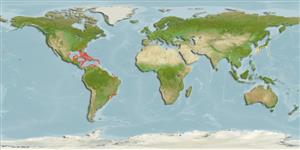Classification / Names
Common names from other countries
Main reference
Size / Weight / Age
Max length : 200 cm SL male/unsexed; (Ref. 6181); common length : 155 cm SL male/unsexed; (Ref. 6181); max. published weight: 1.7 kg (Ref. 5217)
Environment
Marine; benthopelagic; depth range ? - 200 m (Ref. 13628), usually 100 - 200 m (Ref. 13628)
Climate / Range
Deep-water, preferred ?; 35°N - 29°S, 126°E - 39°W (Ref. 6181)
Distribution
Western Atlantic: Bahamas, Caribbean Sea, and off southern Brazil (specimens found at the Institut für Seefischerei, Universität Hamburg collected from 24°40'S, 44°35'W). Northwest Pacific: Cheju Do Island, south of Korean Peninsula.
Countries | FAO areas | Ecosystems | Occurrences | Introductions
Short description
Dorsal
soft rays
(total): 81-90;
Anal
spines: 0;
Anal
soft rays: 60. Lateral line fairly straight, running mid laterally or slightly nearer the ventral contour than the dorsal contour. First anal fin ray scale-like, others ordinal and short. Pelvic fins reduced to a scale-like process spine. Body silvery white with slight red-brownish on dorsal part; several longitudinal pale yellow stripes on body.
IUCN Red List Status (Ref. 115185)
Threat to humans
Harmless
Human uses
Fisheries: subsistence fisheries
More information
Common namesSynonymsMetabolismPredatorsEcotoxicologyReproductionMaturitySpawningFecundityEggsEgg development
ReferencesAquacultureAquaculture profileStrainsGeneticsAllele frequenciesHeritabilityDiseasesProcessingMass conversion
Tools
Special reports
Download XML
Internet sources
Estimates of some properties based on models
Phylogenetic diversity index
PD50 = 0.5625 many relatives (e.g. carps) 0.5 - 2.0 few relatives (e.g. lungfishes)
Trophic Level
4.5 ±0.7 se; Based on size and trophs of closest relatives
Resilience
Medium, minimum population doubling time 1.4 - 4.4 years (Preliminary K or Fecundity.)
Vulnerability
High vulnerability (63 of 100)
Price category
